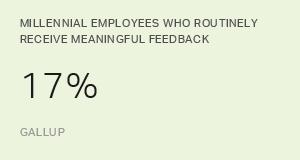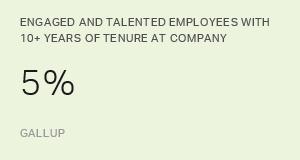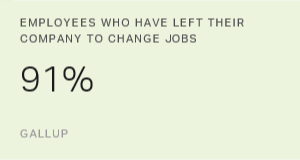Story Highlights
- You can improve the patient experience by investing in employees
- Employees who use their strengths provide a better patient experience
- The right metrics help you monitor and measure employee needs
When was your last ophthalmology visit? For some healthcare leaders, it's time to correct their tunnel vision when it comes to patient satisfaction metrics and data.
Vigilance with patient metrics is understandable, especially as healthcare leaders juggle unrelenting changes to reimbursement and quality-of-care mandates.
But -- while prioritizing patients is critical -- Gallup suggests that an alternative focus can do even more to promote exceptional patient experiences.
Our data reveal that forward-thinking healthcare leaders have dramatically improved the patient experience by first investing in their employees.
That is, to drive patient outcomes, world-class healthcare organizations focus on the big picture: Healthcare is about human beings caring for human beings.
For example, one clinic improved its ranking in the Centers for Medicare & Medicaid Services (CMS) survey of patient satisfaction from about average to among the top 8% of hospitals after leaders recognized that engaged, satisfied caregivers are essential for optimizing the patient experience while promoting safety and quality.
Meeting employees' needs is even more important amid the nursing shortage and the changing nature of work. Millennial employees view work in markedly different ways than previous generations, craving strengths-based development, purpose and meaning in their jobs.
With the ultimate goal of improving patient satisfaction, healthcare leaders need to view their employees as internal customers and holistically invest in employees' needs. Doing so can dramatically improve employee engagement -- and, in turn, HCAHPS scores. Engaged employees are willing to go above and beyond the basic standards of performance -- making them more likely to anticipate patients' needs and create a positive patient experience.
Further, with a culture of engaged employees, healthcare organizations can better attract top talent and entice their star employees to stick around.
The following strategies can help healthcare organizations provide better care for caregivers:
1. Improve internal communication.
As healthcare organizations strive to communicate effectively with patients, it can be easy to overlook internal communication strategies. But effectively conveying information to employees is essential for internal collaboration, patient care, employee engagement and a culture of compliance.
To keep up with emerging technologies and shifting employee demands, healthcare leaders need to discover how employees consume information and accommodate their preferences and needs. For example, some teams might prefer written communication -- such as emails or text messages -- over telephone and face-to-face communication. Others might find that brief team meetings at the start of shifts set the tone for optimal productivity.
Gallup finds that millennials expect ongoing communication and consistent feedback in the workplace. However, just 19% of millennial employees report they receive routine feedback, and just 17% of millennial employees say the feedback they receive is meaningful. To optimize internal communication and meet employees' need for feedback, healthcare managers should facilitate authentic, ongoing conversations with employees.
Further, managers in acute and non-acute care settings should use insights from employee engagement surveys to have meaningful conversations with employees. Measuring engagement is just the beginning; to improve employee performance and quality of care, managers need to use engagement data to establish goals and generate meaningful discussions.
Effective internal communication is also critical for keeping employees aligned with an organization's mission.
Gallup finds that only about one-third of the U.S. workforce strongly agrees that the mission or purpose of their company makes them feel their job is important. All too often, people are attracted to the mission of medicine only to discover that margins affect their day-to-day work more than the mission of their organization does.
To combat this problem, managers should consistently connect employees' work with the big picture -- showcasing and supporting the organization's purpose through both words and actions.
2. Adopt a strengths-based approach.
It's no secret that strong patient-provider connections promote patient compliance and encourage an optimal patient experience. But for many healthcare leaders, training employees to build emotional connections is far more challenging than teaching technical skills.
Implementing a strengths-based approach to managing and developing employees can help hospitals overcome this challenge and tap into employees' innate potential. Gallup finds that a strengths-based management approach helps healthcare teams meet performance goals, interact with patients more effectively and coordinate responsibilities to maximize a team's talents.
When employees understand their strengths -- and what their teammates bring to the table -- they can provide more seamless patient experiences. Caregivers with innate relationship-building strengths, for example, can partner effectively with analytically minded individuals to promote holistic patient care.
To start, managers should discover each employee's unique talents, identify the tasks and activities that each person does best and encourage employees to apply and develop their strengths.
Managers should also infuse employee strengths in ongoing performance development conversations. For example, managers should encourage employees to consider how they can apply their strengths to better achieve their performance goals. Gallup finds that frequent, strengths-based performance development feedback can boost employee engagement threefold.
3. Monitor, measure and manage employee needs using proven metrics.
Healthcare organizations have long recognized the importance of following clinical practices and checklists that are statistically proven to improve quality of care and reduce adverse clinical events. Healthcare leaders should apply the same stringent criteria to employee initiatives -- ensuring that employee practices are validated to drive business metrics and patient outcomes.
For example, Gallup meta-analytic research on 1.2 million employees reveals that organizations that implemented a strengths-based intervention of any magnitude had performance increases across myriad outcomes, including 26% to 72% lower turnover (at high-turnover organizations) and 22% to 59% fewer safety incidents.
Further, people who use their CliftonStrengths every day are six times more likely to be engaged at work.
Amid unrelenting industry change, healthcare organizations need to protect their investments more than ever. By sticking with validated, effective employee interventions, healthcare leaders can better meet employee needs -- and, in turn, improve patient outcomes.
Gallup can help you improve the employee experience with proven tactics:
- Watch one of our healthcare webinars to learn how to lead your organization to greater success.
- Learn how Gallup can help you get better results by focusing on the employee experience.
- Use CliftonStrengths at your organization to get the best out of your people and your business.
Bailey Nelson contributed to the writing of this article.



